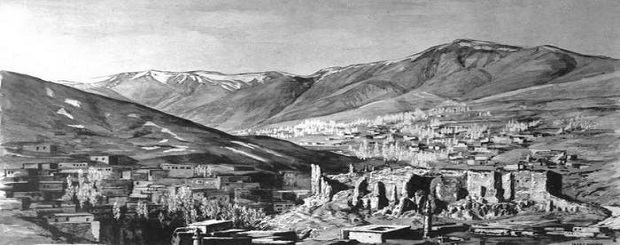
Art-A-Tsolum – Western Armenia – The Ancient Armenian City of Bitlis (Baghesh in Armenian)
July 9, 2019 Antiquities: – Art-A-Tsolum – PREVIOUS ARTICLE:
Bitlis (Baghesh in Armenian) is a city in historical Western Armenia and the center of the Turkish province of the same name. Bitlis Province corresponds to some areas of Greater Armenia’s provinces of Aldznik and Turuberan.
The city is located at an altitude of 1600 meters, about 20 km southwest of Lake Van, south of the Zorapahak mountain pass, at the confluence of Avehu (Hameghajur), Khosrow (Amidol), and other mountain rivers that form the Bitlis River, a tributary of the Tigris.
The city stretches across the valley where these rivers flow and on its surrounding steep slopes that form a huge natural amphitheater. Houses on the slopes are arranged in rows above each other – in the summer, they are surrounded by green gardens.
A folk explanation attributes the establishment of Bitlis to Alexander the Great (4th century BC) – allegedly, the city was built by his order by General Lis, in honor of whom the city was named Bitlis. Previously, one of the sources flowing in the central part of the city was named Alexander.
In antiquity, Bitlis was an Armenian city known as Baghesh, Baghaghesh, and under other names. In Armenian literature, the city is mentioned by historian Sebeos (7th century). Some historians believe that Bitlis was the main city of Aldznik’s Salmadzor district, while others attribute it to Turuberan’s Bznunik district.
Its location at almost all times was convenient in terms of trade and military strategy, which contributed to the growth of the city.
From ancient times, one of the largest roads connecting Trabzon and major cities of central Armenia – Artashat, Dvin, Ani, Kars, and Karin – with Mesopotamia ran through the Bitlis river valley. Under the Artaxiad dynasty, the famous Arkuni road passed here, connecting Artashat and Tigranakert.
Bitlis was conquered several times – in the 7th century, it was ruled by the Arab conquerors and by the Byzantines in the 10th century. At the end of the 10th century, the power in the city passed to the Kurdish tribes that formed a khanate (or emirate) here.
The Kurds more or less retained power in the city until the middle of the 19th century, with the exception of a few decades of conquest by the Seljuks (12th century) and the Qara Qoyunlu (15th century).
In the 16th century, Ottoman Turks captured Bitlis. However, after repelling a number of Turkish attacks, the people of Bitlis forced the Turks to accept their internal autonomy under the leadership of Kurdish leaders.
In the 17th and 18th centuries, the city suffered greatly as a result of continuous clashes between Kurdish tribes. The indigenous population of Bitlis and dozens of Armenian villages were forced out of their settlements.
The city’s autonomy was abolished by the Turkish government in 1849 after the plunder of Bitlis by Turkish troops – in the former territory of the Kurdish khanate, the Bitlis vilayet was founded, which did not enjoy any autonomy.
At the end of the 19th century and at the beginning of the 20th century, the area of the vilayet had an area of over 27 thousand square kilometers.
Kurdish historian, statesman, and military leader Sharafkhan Bidlisi (1543-1603) wrote: “The majority of the population of the city are Armenians.”
In 1878-79, the population of the vilayet was about 400 thousand people, of which 250 thousand were Armenians. At the end of the century, the city’s population was 382 thousand, of which 180 thousand were Armenians. However, the Muslim population was already prevailing (mostly Kurds). According to the Armenian Patriarchate of Constantinople, in 1880, 10 thousand 724 people of Armenian nationality lived in the city of Bitlis.
According to official Turkish data, at the beginning of the 20th century, the Armenian population in the city was 14-15 thousand (out of 40 thousand in total).
In 1894–96, pogroms and robberies were committed in all Armenian settlements of Bitlis Province. About a thousand Armenians were slaughtered in the city of Bitlis. Many were forcibly converted to Mohammedanism.
Nevertheless, up to 1915, Armenians have remained the most numerous ethnic group in the vilayet. During the Genocide of 1915, the Armenian population of Bitlis was completely exterminated.
Only in the Bitlis district, 15 thousand Armenians were killed. The massacres were carried out by units of the regular Turkish army under the direct supervision of Governor of Van Jevded. A small share of the Armenian population that had avoided death found refuge in Eastern Armenia.
Author: Alexander Bakulin
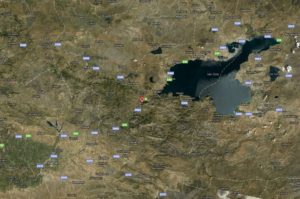
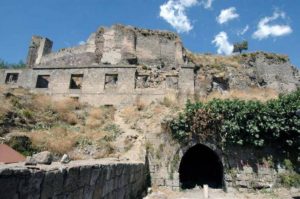
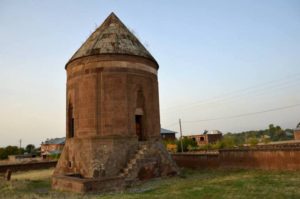
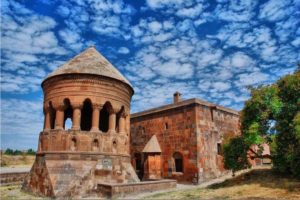
allinnet.info/antiquities/the-ancient-armenian-city-of-bitlis/
